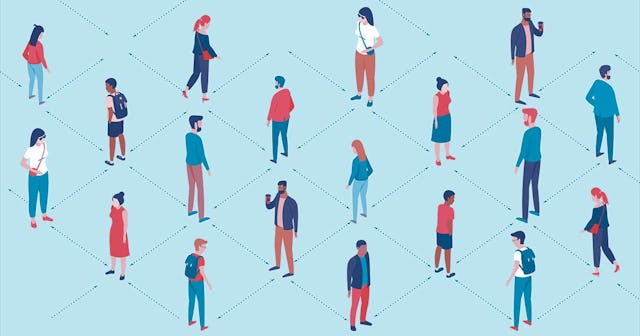What The Hell Is A 'Contact Tracer'?

Most of us are hearing the term “contact tracing” for the first time—unless you work in public health or epidemiology, prior to the pandemic you wouldn’t have had any reason to have ever encountered the phrase.
Contact tracing is a three-pronged process of identifying, notifying, and tracking folks who may have been exposed to coronavirus. It’s one of the most important tools we have—in conjunction with testing—for preventing the spread of contagious diseases like COVID-19.
How does contact tracing work?
The first aspect of contact tracing seems simple enough: identify the contacts of infected people. Of course, this assumes that we have reliable testing that yields quick results in order to identify infection so that a sick person’s contacts can be quickly tracked down and isolated. Waiting three to five days for test results would greatly diminish the effectiveness of contact tracing. It also helps if people are making a habit of limiting their exposure to other people by avoiding large groups and crowded places as well as keeping track of those with whom they come into contact.
Once contacts have been identified, these individuals are then required to quarantine. An important part of tracing is ensuring the “safe, sustainable, and effective quarantine” of known contacts. Because coronavirus has a lengthy incubation period, it’s important that people who have been in contact with a confirmed case immediately isolate. Contact tracing supports this effort.
How is contact tracing implemented?
Good contact tracing is a collaborative, cooperative effort. States, tribes, and localities must work together to implement a program that is actually effective in stopping the spread of COVID-19. That requires training in the use of the digital tools that would allow people to do this job properly.
Currently, we don’t have enough contact tracers. 1.7 million people in the United States have been infected, with about 100,000 deaths as of this writing and anywhere from 13,000 to 26,000 new cases per day according to the CDC’s website.
CDC website 5/27/20
Does contact tracing really work?
In a word: yes.
Though our modern economy presents unique challenges—imagine trying to contact trace an entire crowded subway car or a packed football stadium—it is still possible to use contact tracing, especially if we utilize human teams and available technology as some other countries have successfully done.
Iceland, for example, began contact tracing early on. Their restrictions were lax by U.S. standards, with schools and nurseries still open so parents could continue to work, but whenever a case was identified (via extensive testing), an “aggressive” plan of contact tracing went into effect, isolating any individuals who’d come into close contact with the infected person. They found that 60% of new cases were appearing in people who had already isolated as a result of contact tracing. In other words, those new cases did not spread the infection.
Trust and solidarity is required for contact tracing to be effective, though. Unfortunately, here in the U.S. there are still people who insist COVID-19 is like the flu or that it’s a hoax or that everyone is “overreacting.” Many also fear that contact tracing is nothing more than an invasion of privacy and might refuse to cooperate. That doesn’t bode well for the U.S. in terms of making contact tracing a success, but hopefully health authorities can appeal to people’s eagerness to open the economy and return to some semblance of normal as a way to participate and do their part when it comes to contact tracing.
Could you be a contact tracer?
Given that such a huge number of people are currently out of work, many are wondering if they could find work as a contact tracer. The answer might very well be “yes.”
As of now, the U.S. does not have federal-level plans for implementing intensive contact tracing. But CBS News reports that city and state health departments are looking to implement their own plans and are hiring thousands of individuals to train to become contact tracers. The position pays up to $65,000 per year and will be in demand across the nation until COVID-19 is brought to heel.
Roger Shapiro told CBS News that “it’s something that people can be trained to do.” He said that though the position definitely requires training, “it’s not impossible to train almost anybody with reasonable social skills, who can work off a script, begin a conversation with people, convey a few key messages and collect data.”
Matthew Henr/Burst
Given what we know about how coronavirus spreads, and because the U.S.’s plan to open up cautiously, in stages, blew up into a frantic free-for-all over Memorial Day weekend, it is likely we’ll see a surge of new coronavirus cases in the next few weeks. Contact tracing could be key to isolating these individuals’ contacts and preventing further spread.
One might assume that contact tracers should be experts or have years of experience in healthcare. But experts agree that applicants don’t necessarily need to have any experience at all in the healthcare field—though it is a bonus if you’re comfortable with medical terminology. Far more important are “strong interpersonal skills and empathy.” Consider that contact tracers are required to speak to people who aren’t feeling well and then to that person’s contacts who may feel perfectly fine but must be convinced to self-quarantine for up to two weeks. So the job definitely requires a certain kind of personality.
The larger point here is that contact tracing is a trainable position, and one that is very much in need if we want to be able to have a somewhat open economy and still control the spread of coronavirus. If you think you’d make a great contact tracer, contact your local and state health departments to find out if they’re hiring.
This article was originally published on